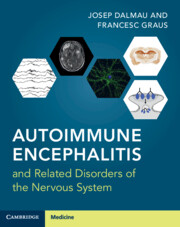Book contents
- Autoimmune Encephalitis and Related Disorders of the Nervous System
- Autoimmune Encephalitis and Related Disorders of the Nervous System
- Copyright page
- Dedication
- Contents
- Clinical Vignettes
- Videos
- Preface
- Abbreviations
- Section 1 Overview
- Section 2 Antibodies and Antigens
- Section 3 Specific Syndromes and Diseases
- Section 4 Autoimmunity in Neurological and Psychiatric Diseases
- Chapter 19 Autoimmune Psychosis
- Chapter 20 Psychiatric Manifestations of Autoimmune Encephalitis
- Chapter 21 Abnormal Movements in Neurological Autoimmune Disorders
- Chapter 22 Sleep and Autoimmunity
- Chapter 23 Immunity, Inflammation, and Epilepsy
- Chapter 24 Autoimmune Dementia: A Useful Term?
- Chapter 25 Frequently Asked Questions on Autoimmune Encephalitis and Related Disorders
- Index
- References
Chapter 22 - Sleep and Autoimmunity
from Section 4 - Autoimmunity in Neurological and Psychiatric Diseases
Published online by Cambridge University Press: 27 January 2022
- Autoimmune Encephalitis and Related Disorders of the Nervous System
- Autoimmune Encephalitis and Related Disorders of the Nervous System
- Copyright page
- Dedication
- Contents
- Clinical Vignettes
- Videos
- Preface
- Abbreviations
- Section 1 Overview
- Section 2 Antibodies and Antigens
- Section 3 Specific Syndromes and Diseases
- Section 4 Autoimmunity in Neurological and Psychiatric Diseases
- Chapter 19 Autoimmune Psychosis
- Chapter 20 Psychiatric Manifestations of Autoimmune Encephalitis
- Chapter 21 Abnormal Movements in Neurological Autoimmune Disorders
- Chapter 22 Sleep and Autoimmunity
- Chapter 23 Immunity, Inflammation, and Epilepsy
- Chapter 24 Autoimmune Dementia: A Useful Term?
- Chapter 25 Frequently Asked Questions on Autoimmune Encephalitis and Related Disorders
- Index
- References
Summary
This chapter focuses on several types of sleep disorders in patients with autoimmune encephalitis, including narcolepsy, REM sleep behaviour disorder (RBD), NREM sleep parasomnias, and central and obstructive sleep apnoeas. Narcolepsy is a chronic sleep disorder characterized by excessive daytime sleepiness and severe and irresistible episodes of daytime sleep. Narcolepsy is caused by a T cell-mediated destruction of hypocretin-synthetizing neurons located in the hypothalamus. Patients with anti-NMDAR encephalitis develop severe insomnia at disease onset, and many of them have hypersomnia after the acute stage of the disease or during clinical recovery. Patients with anti-LGI1 encephalitis frequently develop REM sleep behaviour disorder. Patients with Morvan syndrome and CASPR2 antibodies present a sleep disorder called agrypnia excitata that consists of severe insomnia, motor and sympathetic hyperactivity, quasi-purposeful movements, and enacted dreams in the setting of loss of slow-wave sleep and circadian rhythmicity. Sleep alterations occur in >80% of patients with anti-IgLON5 disease; the most characteristic are sleep apnoeas and non-REM and REM parasomnias. Symptoms of excessive daytime sleepiness, sometimes with findings suggestive of narcolepsy, were reported in about 30% of patients with paraneoplastic anti-Ma2 encephalitis, and less frequently in patients with neuromyelitis optica spectrum disorders associated with aquaporin 4 antibodies.
Keywords
- Type
- Chapter
- Information
- Publisher: Cambridge University PressPrint publication year: 2022

